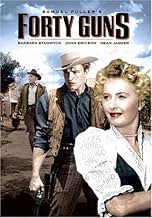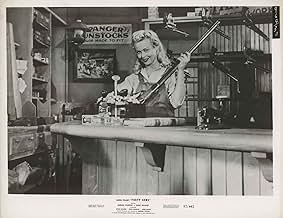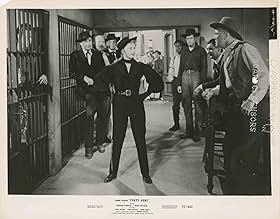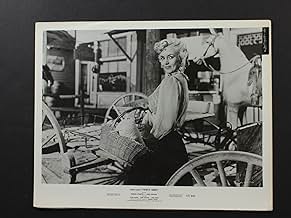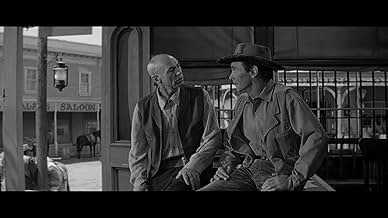CALIFICACIÓN DE IMDb
6.9/10
6.9 k
TU CALIFICACIÓN
Cuando el alguacil de un pueblo decide arrestar a uno de los miembros de un ejército de vaqueros, el equilibrio del lugar comienza a cambiar radicalmente.Cuando el alguacil de un pueblo decide arrestar a uno de los miembros de un ejército de vaqueros, el equilibrio del lugar comienza a cambiar radicalmente.Cuando el alguacil de un pueblo decide arrestar a uno de los miembros de un ejército de vaqueros, el equilibrio del lugar comienza a cambiar radicalmente.
Sandy Wirth
- Chico's Girlfriend
- (as Sandra Wirth)
Albert Cavens
- Doctor
- (sin créditos)
Tex Driscoll
- Barber
- (sin créditos)
- Dirección
- Guionista
- Todo el elenco y el equipo
- Producción, taquilla y más en IMDbPro
Opiniones destacadas
Forty Guns (1957)
Sam Fuller's style is uncompromising and over the top. He pushes both melodrama and visual drama. And he's also extremely astute handling the actors and the space and light they move through. His movies are definitely experiences, from "The Naked Kiss" to "The Big Red One" all the way back to the masterpiece, "Pickup on South Street."
And he usually tells a strong clear story. That's the big weakness here. It's as if all the over-sized elements, including Barbara Stanwyck as this unlikely woman power queen frontier figure with forty men at her beck and call, are juggled around enough to keep it interesting just on their own. Not only will the progress of events be sometimes confusing, it will at times also be too unlikely to hold water, which is even worse.
Not that the movie isn't a thrill to watch. I mean watch, with your eyes. The sparkling widescreen photography is so good, so very good and original, you can't help but like that part of it. In a way that's sustaining--it's what kept me glued. But that's my thing. I'm a photographer. I love the physical structure of movies. This movie was made for me. It's made to be studied.
And that's what "Forty Guns" is famous for, an over-sized influence. The French writers of the time (like Godard) and some later American upstarts (like Tarantino) have praised the filmmaking, if not always the film. You can certainly see, and appreciate, how much a movie like this foreshadowed the spaghetti westerns which have become so famous, but which were made six and more years later.
And that's worth remembering, too. Westerns, as a genre, are well worn by now. The themes have been worked and overworked. To make a new fresh western means pushing it to some limit, and for Fuller that means a soap opera exaggeration. That means galloping horses endlessly around a waiting stagecoach as the horses jump in fear. That means a man walking up to his rival and walking and walking, far longer than it would take to cover the hundred yards shown, until reaching him and punching, not shooting him. It means a final glorious scene that is shown farther and farther in the distance and all you see are two little dots as figures--and yet you know what just happened, and how satisfying that is.
And how unreasonable the events were getting us to that point. "Forty Guns" plays loose with archetypes in a pre-post-modern way that has made it weirdly contemporary. Fuller's films, like his unlikely contemporary Douglas Sirk's, have taken on a life of their own, as flawed as they are. This may not be the best place to start to love his work, but it's a good place to start to understand where movies had gotten to--some would say fallen--by the late 1950s. Check it out.
Sam Fuller's style is uncompromising and over the top. He pushes both melodrama and visual drama. And he's also extremely astute handling the actors and the space and light they move through. His movies are definitely experiences, from "The Naked Kiss" to "The Big Red One" all the way back to the masterpiece, "Pickup on South Street."
And he usually tells a strong clear story. That's the big weakness here. It's as if all the over-sized elements, including Barbara Stanwyck as this unlikely woman power queen frontier figure with forty men at her beck and call, are juggled around enough to keep it interesting just on their own. Not only will the progress of events be sometimes confusing, it will at times also be too unlikely to hold water, which is even worse.
Not that the movie isn't a thrill to watch. I mean watch, with your eyes. The sparkling widescreen photography is so good, so very good and original, you can't help but like that part of it. In a way that's sustaining--it's what kept me glued. But that's my thing. I'm a photographer. I love the physical structure of movies. This movie was made for me. It's made to be studied.
And that's what "Forty Guns" is famous for, an over-sized influence. The French writers of the time (like Godard) and some later American upstarts (like Tarantino) have praised the filmmaking, if not always the film. You can certainly see, and appreciate, how much a movie like this foreshadowed the spaghetti westerns which have become so famous, but which were made six and more years later.
And that's worth remembering, too. Westerns, as a genre, are well worn by now. The themes have been worked and overworked. To make a new fresh western means pushing it to some limit, and for Fuller that means a soap opera exaggeration. That means galloping horses endlessly around a waiting stagecoach as the horses jump in fear. That means a man walking up to his rival and walking and walking, far longer than it would take to cover the hundred yards shown, until reaching him and punching, not shooting him. It means a final glorious scene that is shown farther and farther in the distance and all you see are two little dots as figures--and yet you know what just happened, and how satisfying that is.
And how unreasonable the events were getting us to that point. "Forty Guns" plays loose with archetypes in a pre-post-modern way that has made it weirdly contemporary. Fuller's films, like his unlikely contemporary Douglas Sirk's, have taken on a life of their own, as flawed as they are. This may not be the best place to start to love his work, but it's a good place to start to understand where movies had gotten to--some would say fallen--by the late 1950s. Check it out.
If you've never seen this film, I think you'll find it a bit different from most classic westerns. It's really more of a film noir, I thought, and I liked that angle. I say "film noir" because of feel. This western had stark black-and-white photography with tons of shadows and it had a dramatic scene near the end that was very noir-ish. I was very impressed with the ending, and that's all I will say as to not spoil it for others.
The DVD has the option of fullscreen or widescreen. Please consider the latter, because that is how it was presented: in "cinemascope," and you'll want to see photographer Joseph Birac's work in all its glory.
For Barbara Stanwyck fans, this might be a little disappointing because Barry Sullivan is the star of the film, not her, despite the billing. Sullivan plays "Griff Bonnell" and he is the principal figure in the movie, although Stanwyck's presence and character in the story are very strong as "Jessica Drummond." "Griff," along with his brothers, played by Gene Barry and Robert Dix, have more lines than Stanwyck, who doesn't even come on screen until 20 of the 80 minutes have elapsed.
All the characters are pretty interesting, however, no matter what their screen time. Those include some strange supporting roles, particularly two lawmen who don't sound and act like lawmen: Hank Worden's marshal role in the beginning and Dean Jagger's stint as the sheriff who has designs on Stanwyck.
To repeat, this is an odd story. I mean, how often does one see a tornado in the middle of a western movie? Some of the lines in here were quite profound, too, and some were uttered really stupidly. It's a curiosity piece, that's for sure.....but definitely worth watching if good photography and odd characters interest you.
The DVD has the option of fullscreen or widescreen. Please consider the latter, because that is how it was presented: in "cinemascope," and you'll want to see photographer Joseph Birac's work in all its glory.
For Barbara Stanwyck fans, this might be a little disappointing because Barry Sullivan is the star of the film, not her, despite the billing. Sullivan plays "Griff Bonnell" and he is the principal figure in the movie, although Stanwyck's presence and character in the story are very strong as "Jessica Drummond." "Griff," along with his brothers, played by Gene Barry and Robert Dix, have more lines than Stanwyck, who doesn't even come on screen until 20 of the 80 minutes have elapsed.
All the characters are pretty interesting, however, no matter what their screen time. Those include some strange supporting roles, particularly two lawmen who don't sound and act like lawmen: Hank Worden's marshal role in the beginning and Dean Jagger's stint as the sheriff who has designs on Stanwyck.
To repeat, this is an odd story. I mean, how often does one see a tornado in the middle of a western movie? Some of the lines in here were quite profound, too, and some were uttered really stupidly. It's a curiosity piece, that's for sure.....but definitely worth watching if good photography and odd characters interest you.
Barbara Stanwyck (hard as nails) plays a powerful rancher with political ties near Tombstone whose hired hands, mostly crooked and lead by her own brother, bring her together with Barry Sullivan of the U.S. Attorney General's office, out to arrest one of her boys for robbery. Surprisingly brutal and adult western from Globe Enterprises and distributed by Twentieth Century-Fox, written and directed by Samuel Fuller as if he were trying to find a place for every western cliché in the filmmaker's manual. Joseph Biroc's moody black-and-white cinematography gives the proceedings an intensity that elevates the script, even as Fuller's staging--particularly the gun-blazing confrontations--typically run the gamut from florid to outrageous. Sullivan is sturdy (and colorless) as usual; Stanwyck has this type of role down pat. **1/2 from ****
Aided by her trigger-happy brother and a small army, a cattle queen owns the county including the sheriff. But there's trouble when a marshal arrives who has a trigger-happy brother of his own. Thus a load of complications ensue.
Interesting, if not wholly successful, western. There's really too many principal characters and plot for the limited time frame (79-min's.). Nonetheless, director and screenwriter Fuller manage a few real surprises. Then too, this may be the "walkingest" horse opera I've seen – note how many tracking shots Fuller manages of people walking. This may be a budget consideration since little action occurs away from town. The forty guns are forty guys riding behind queen bee Jessica (Stanwyck) like a mounted army. Oddly, these guys never talk even after being dismissed from the extra-long dinner table, and soon disappear when Jessica's little empire crumbles. There are a lot of cross-currents to the highly involved plot line, so you may need the proverbial scorecard to keep up.
Unsurprisingly, Stanwyck is imperious as the big cheese running both her ranch and the town, while Sullivan is appropriately steely-eyed as the town tamer. But give John Ericson (Brockie) an upside-down Oscar for the worst over-the-top mugging since The Three Stooges. At the same time, Jagger does well as the spineless Sheriff in the employ of queen bee Jessica. Fuller shows real style at times. He certainly knows how to subvert western cliché and keep audience interest. However, in my little book, this is not one of his better films, basically because of a crowded script and budgetary limitations. I mean a lot of money went into the name cast that perhaps had to be made up elsewhere as in the pedestrian settings. All in all, it's, a rather exotic if not exactly memorable western.
Interesting, if not wholly successful, western. There's really too many principal characters and plot for the limited time frame (79-min's.). Nonetheless, director and screenwriter Fuller manage a few real surprises. Then too, this may be the "walkingest" horse opera I've seen – note how many tracking shots Fuller manages of people walking. This may be a budget consideration since little action occurs away from town. The forty guns are forty guys riding behind queen bee Jessica (Stanwyck) like a mounted army. Oddly, these guys never talk even after being dismissed from the extra-long dinner table, and soon disappear when Jessica's little empire crumbles. There are a lot of cross-currents to the highly involved plot line, so you may need the proverbial scorecard to keep up.
Unsurprisingly, Stanwyck is imperious as the big cheese running both her ranch and the town, while Sullivan is appropriately steely-eyed as the town tamer. But give John Ericson (Brockie) an upside-down Oscar for the worst over-the-top mugging since The Three Stooges. At the same time, Jagger does well as the spineless Sheriff in the employ of queen bee Jessica. Fuller shows real style at times. He certainly knows how to subvert western cliché and keep audience interest. However, in my little book, this is not one of his better films, basically because of a crowded script and budgetary limitations. I mean a lot of money went into the name cast that perhaps had to be made up elsewhere as in the pedestrian settings. All in all, it's, a rather exotic if not exactly memorable western.
Forty Guns is written and directed by Sam Fuller. It stars Barbara Stanwyck, Barry Sullivan, Dean Jagger, John Ericson, Gene Barry, Robert Dix, Eve Brent and Ziva Rodann. Music is by Harry Sukman and cinematography by Joseph F. Biroc.
It's all going to kick off in Arizona between the Bonnell brothers, U.S.Marshals, and Jessica Drummond - the tough no nonsense lady rancher who controls the territory.
So what do we have here then? Just another recycled Western plot that is basically the Earp's/Clanton's feud that culminated in the Gunfight At The O.K. Corral? Well no, not really, for this is Sam Fuller on devilishly twisty form.
Fuller gives this particular Western a film noir make over, both in look and dialogue innuendo. Pic is filled with outstanding sequences, be it shocking deaths, bravado pumped show downs or chiaroscuro framing of key characters, no frame is wasted in this piece - visually or aurally.
From a psychological stand point it's a right hornets nest, a meaty broth of cynical observations on love, power and that bastion of American cinema - the Western. The action construction on offer is electrifying, if Fuller isn't dallying with various camera techniques to keep the story on the hop, he's being kinetic with his action filming. All of which is in the Scope format, with the ace Biroc weaving some monochrome magic.
Probably now it has risen above being just a cult Western classic, Fuller's standing in the decades that would follow this release have ensured that to be the case. Yet it is noted that this holds no surprises in how story eventually pans out, which is disappointing given the noir pulse beats driving it forward. In fact a charge of schmaltz at pics end is justified and stops this being the masterpiece many of us yearn it to be.
Still, tis a superb genre piece of some considerable substance. A film that begs to be revisited on more than one occasion. Thank You Samuel. 8/10
It's all going to kick off in Arizona between the Bonnell brothers, U.S.Marshals, and Jessica Drummond - the tough no nonsense lady rancher who controls the territory.
So what do we have here then? Just another recycled Western plot that is basically the Earp's/Clanton's feud that culminated in the Gunfight At The O.K. Corral? Well no, not really, for this is Sam Fuller on devilishly twisty form.
Fuller gives this particular Western a film noir make over, both in look and dialogue innuendo. Pic is filled with outstanding sequences, be it shocking deaths, bravado pumped show downs or chiaroscuro framing of key characters, no frame is wasted in this piece - visually or aurally.
From a psychological stand point it's a right hornets nest, a meaty broth of cynical observations on love, power and that bastion of American cinema - the Western. The action construction on offer is electrifying, if Fuller isn't dallying with various camera techniques to keep the story on the hop, he's being kinetic with his action filming. All of which is in the Scope format, with the ace Biroc weaving some monochrome magic.
Probably now it has risen above being just a cult Western classic, Fuller's standing in the decades that would follow this release have ensured that to be the case. Yet it is noted that this holds no surprises in how story eventually pans out, which is disappointing given the noir pulse beats driving it forward. In fact a charge of schmaltz at pics end is justified and stops this being the masterpiece many of us yearn it to be.
Still, tis a superb genre piece of some considerable substance. A film that begs to be revisited on more than one occasion. Thank You Samuel. 8/10
¿Sabías que…?
- TriviaBarbara Stanwyck's stunt woman refused to be dragged by a horse, saying that it was too dangerous. Without further ado, Stanwyck did it by herself. She got some bruises and scrapes, but was okay. At that time, she was 49 years old.
- ErroresWhen the gunsmith is fitting Wes for a new rifle, he is holding the stock from a model 1898 Mauser, which would not be invented for another 20 years. Wes also picks up a Winchester and looks through the barrel to see the lady gunsmith, which is not possible due to there being no straight line of sight through the action.
- Citas
Jessica Drummond: I'm not interested in *you*, Mr. Bonnell. It's your trademark.
[gestures at his gun, purring]
Jessica Drummond: May I feel it?
Griff Bonnell: Uh-uh.
Jessica Drummond: Just curious.
Griff Bonnell: It might go off in your face.
Jessica Drummond: I'll take a chance.
- ConexionesEdited into Gli ultimi giorni dell'umanità (2022)
Selecciones populares
Inicia sesión para calificar y agrega a la lista de videos para obtener recomendaciones personalizadas
- How long is Forty Guns?Con tecnología de Alexa
Detalles
Taquilla
- Presupuesto
- USD 300,000 (estimado)
- Total a nivel mundial
- USD 6,344
- Tiempo de ejecución1 hora 20 minutos
- Color
- Relación de aspecto
- 2.35 : 1
Contribuir a esta página
Sugiere una edición o agrega el contenido que falta

Principales brechas de datos
By what name was Dragones de la violencia (1957) officially released in India in English?
Responda

